Why you can trust Tom's Hardware
Comparison Products
Our M.2 2230 stable has begun to fill out nicely, and we’re glad to finally have the WD Black SN770M on board. It’s a shortened Black SN770, which, in turn, has a popular OEM counterpart in the Black SN740. We’re also testing at 2TB, where the SN740 is most popular because it has brought TLC at that capacity, and now the SN770M is a full-fledged retail option.
The SN770M will face our best 1TB TLC drives, including the Sabrent Rocket 2230, the Corsair MP600 Mini, and the Inland TN446. These are the most popular M.2 2230 SSDs around. Selecting QLC flash can save you some money at 1TB, however, with the Teamgroup MP44S, or you can use older hardware - which many generic options do - with the Inland TN436. Then, we usher in the 2TB QLC alternatives, which induce the Silicon Power UD90 2230, the Inland QN446, and the Sabrent Rocket Q4 2230.
Steam Deck - General
To gauge general Steam Deck performance we engage in a variety of typical storage situations with active time measurement. These activities include dealing with the default SteamOS through initial setup, re-imaging, initial booting, and booting in general. For game testing we see how long it takes to install and boot the popular title Hollow Knight. For a full explanation of our testing procedure, see our main article.






The SN770M handled general Steam Deck tasks without any problem, coming in as average or better in every test.
We also tested battery life over an hour of gameplay. We found no real impact driven by drive choice, suggesting that the average game session has minimal I/O when stretched over time and that the Steam Deck is excellent at reducing its drive’s power states. There will be a larger impact for tasks outside of gaming, which could include content creation with a Surface or other device.
Additionally, this was tested under SteamOS, and if you are running under Windows and/or with more aggressive performance-to-power settings, we suspect the SN770M would be a significant outlier. This is especially true with PCIe 4.0-capable devices. The SN770M often performs better but pulls more peak and average power and is significantly less efficient than the other drives tested. It also produced significantly more heat in our desktop testing. Keep this in mind when selecting your drive.
Steam Deck - KDiskMark and Temperature
One of the most popular, if not the most popular, storage benchmarks is CrystalDiskMark (CDM), which we use in our own Windows-based SSD testing suite. This benchmark relies on Microsoft’s DiskSpd with templated test settings. CDM lets you quickly see how a drive performs against its idealized, rated specifications and the benchmark can also hint at a more “real world” feel with low queue depth I/O testing.
Get Tom's Hardware's best news and in-depth reviews, straight to your inbox.
The Linux flavor of this benchmark, which is easy to install on the Steam Deck, is KDiskMark. The “K” refers to the KDE desktop environment used on the Deck. KDiskMark relies on the Flexible I/O tester, or FIO, instead of DiskSpd. For the temperature portion we use data from the SMART sensors on the drive which can be directly polled and from which the maximum temperature can be extracted.









The SN770’s KDiskMark performance was all over the place, but it performed above average with QD1 random reads. This result is usually a good gauge of “feel.” The other TLC drives can perform better, but there are some caveats. The first is that your experience is unlikely to differ between these drives. The second is that the SN770M is being tested at 2TB, and it might score a little better at 1TB, as is the case with the original SN770. That said, if your drive will be fuller a lot of the time, you might have edge cases where the more consistent drives - the Rocket 2230 or MP600 Mini, for two - will be the best option. If you need 2TB, though, the SN770M has no problem facing down its QLC-based opponents.
The SN770M fell into the middle of the pack when it came to temperature during our Deck-specific testing. The Deck is limited to PCIe 3.0 speeds and is also very conservative with power consumption. As a result, the SN770M - or any other drive for that matter - did not have sufficient time to fully heat up. Most of the Deck’s heat will come from the APU, that is, the CPU and GPU load with gaming, which will toast these drives over time. In some cases, this will lead to throttling, which is more likely with the SN770M given our desktop testing and even more likely in PCIe 4.0-compatible devices.
PC Trace Testing - 3DMark Storage Benchmark
Built for gamers, 3DMark’s Storage Benchmark focuses on real-world gaming performance. Each round in this benchmark stresses storage based on gaming activities including loading games, saving progress, installing game files, and recording gameplay video streams.
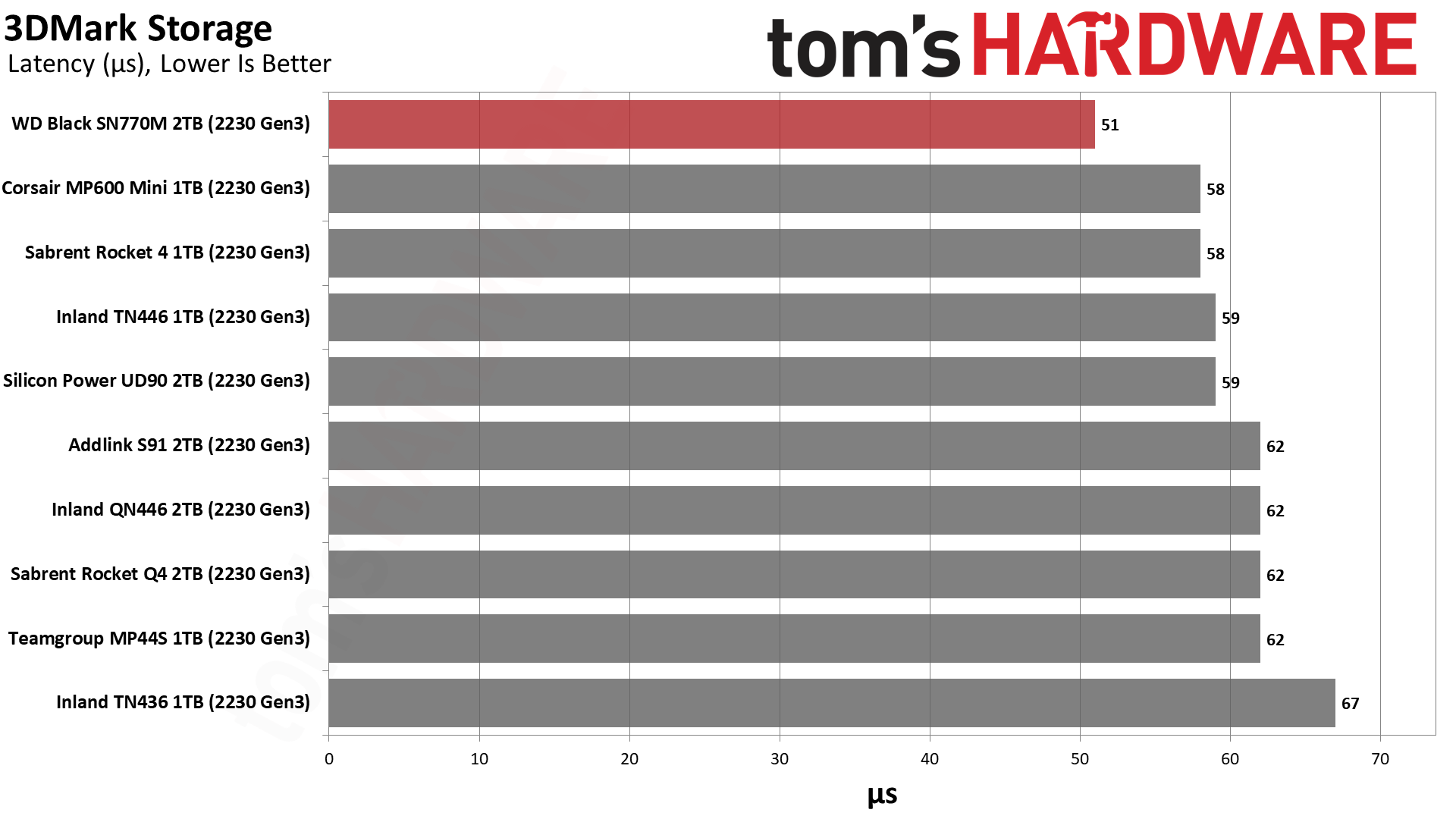





The SN770M clearly has the best performance in 3DMark, bringing the fastest marks we’ve seen for any 2230 SSD. It easily surpasses the 2TB QLC options in PCIe 3.0 and 4.0 modes. We do not have the 1TB to test, but it might score even higher as it should use less-dense dies.
WD makes a point of explicitly stating the drive has DirectStorage support in the datasheet, but this isn’t particularly relevant as the technology is supported more generally. We did take a look at DirectStorage-like performance last year with Phison’s I/O+ firmware - which is on Gen 5 SSDs, the Sabrent Rocket 4 Plus-G, and available as an update to the Seagate FireCuda 530 - but we haven’t found a suitable real-world test thus far.
PC Trace Testing – PCMark 10 Storage Benchmark
PCMark 10 is a trace-based benchmark that uses a wide-ranging set of real-world traces from popular applications and everyday tasks to measure the performance of storage devices.

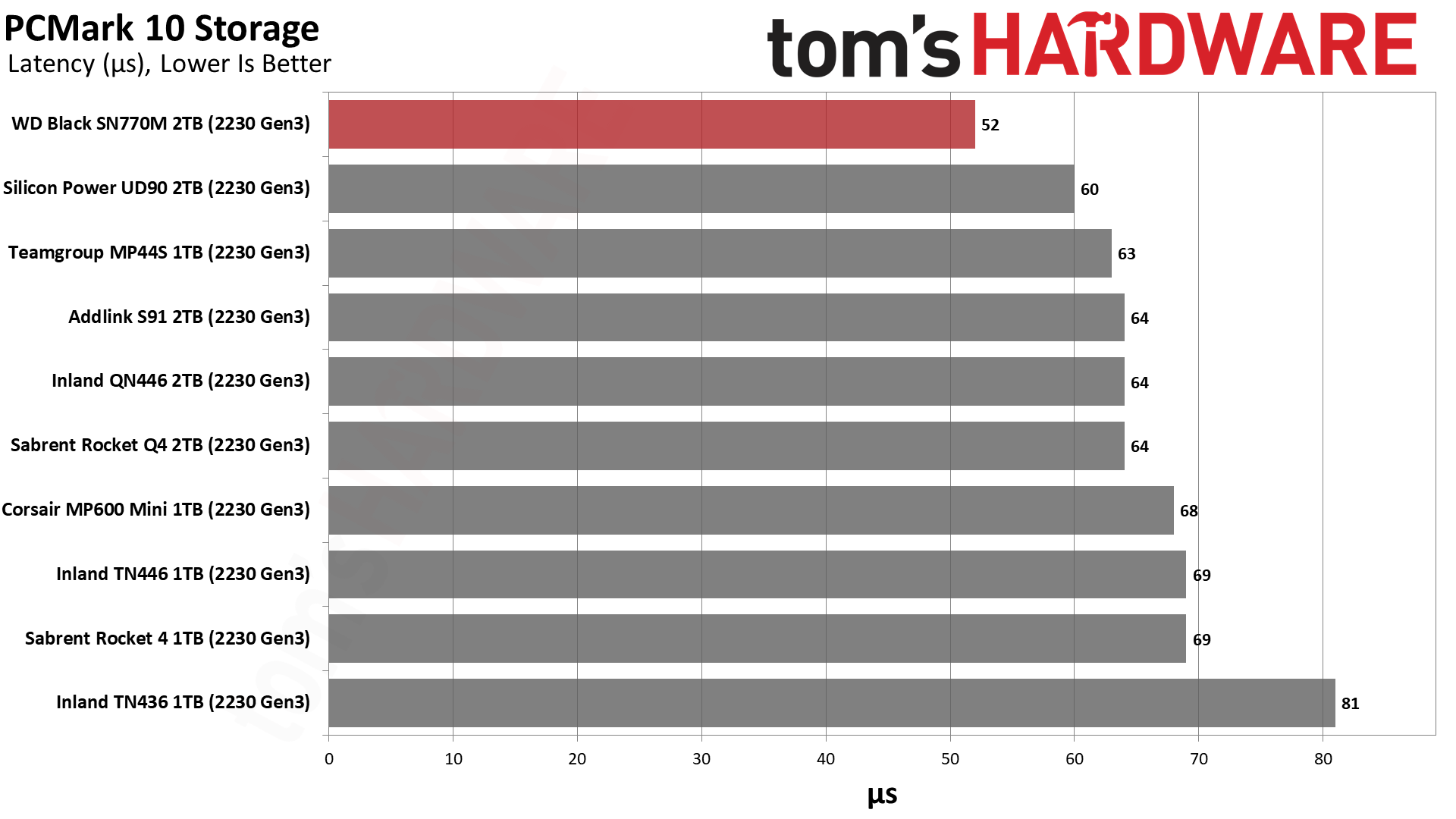




The SN770M also takes the crown in PCMark 10, delivering the best 2230 results we have seen to date. It’s the fastest SSD you can get in this form factor, especially if you want 2TB in single-sided goodness.
PC Transfer Rates – DiskBench
We use the DiskBench storage benchmarking tool to test file transfer performance with a custom, 50GB dataset. We copy 31,227 files of various types, such as pictures, PDFs, and videos to a new folder and then follow-up with a reading test of a newly-written 6.5GB zip file.
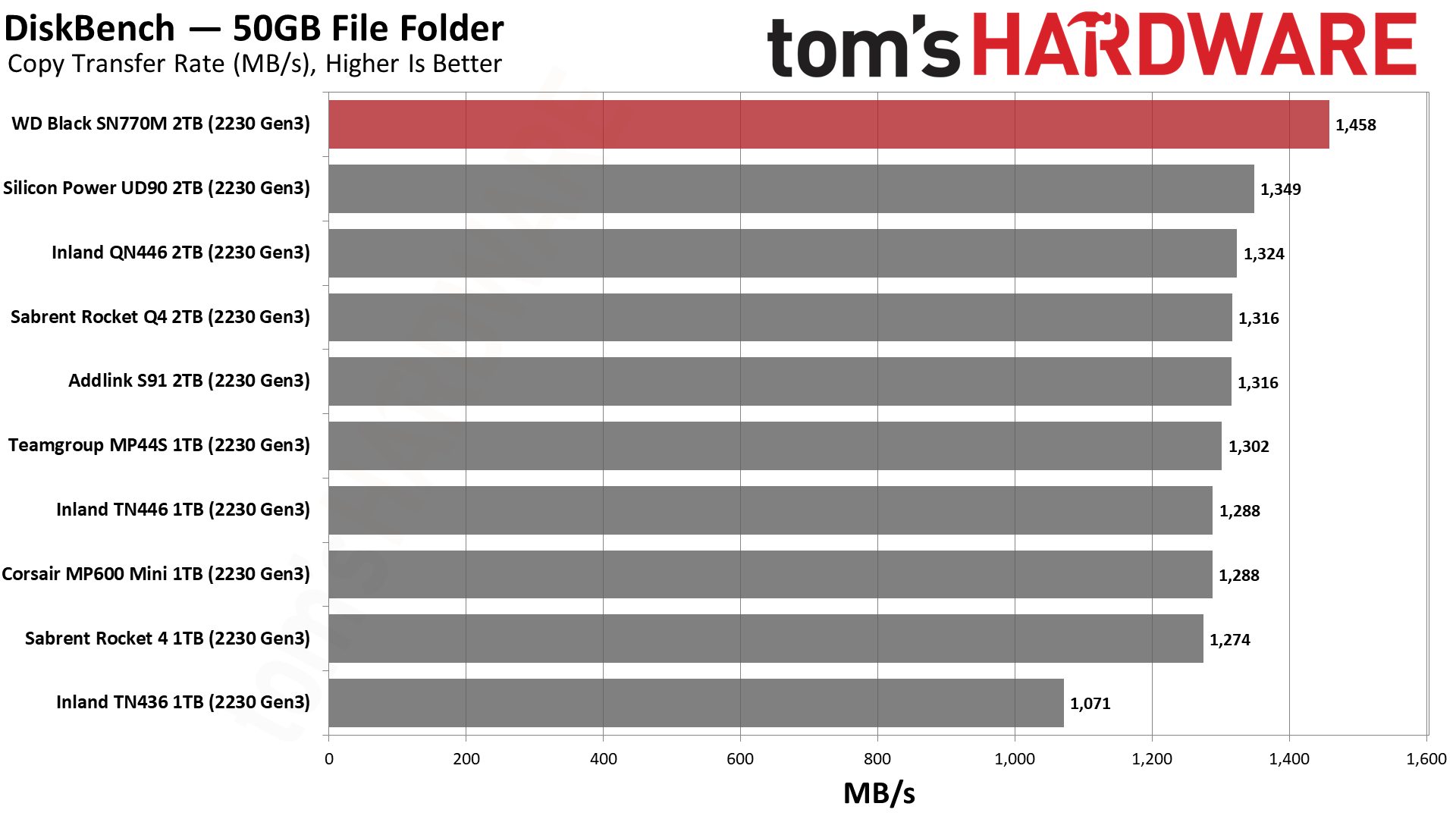





DiskBench is not the most relevant test for 2230 drives as they often end up as the only drive in tight environments where bandwidth cannot be fully achieved. That said, the SN770M does copy the fastest in PCIe 3.0 mode, although the other drives are not far behind. In PCIe 4.0 mode, it’s challenged by the Rocket 2230 and MP600 Mini.
PC Synthetic Testing - ATTO / CrystalDiskMark
ATTO and CrystalDiskMark (CDM) are free and easy-to-use storage benchmarking tools that SSD vendors commonly use to assign performance specifications to their products. Both of these tools give us insight into how each device handles different file sizes.









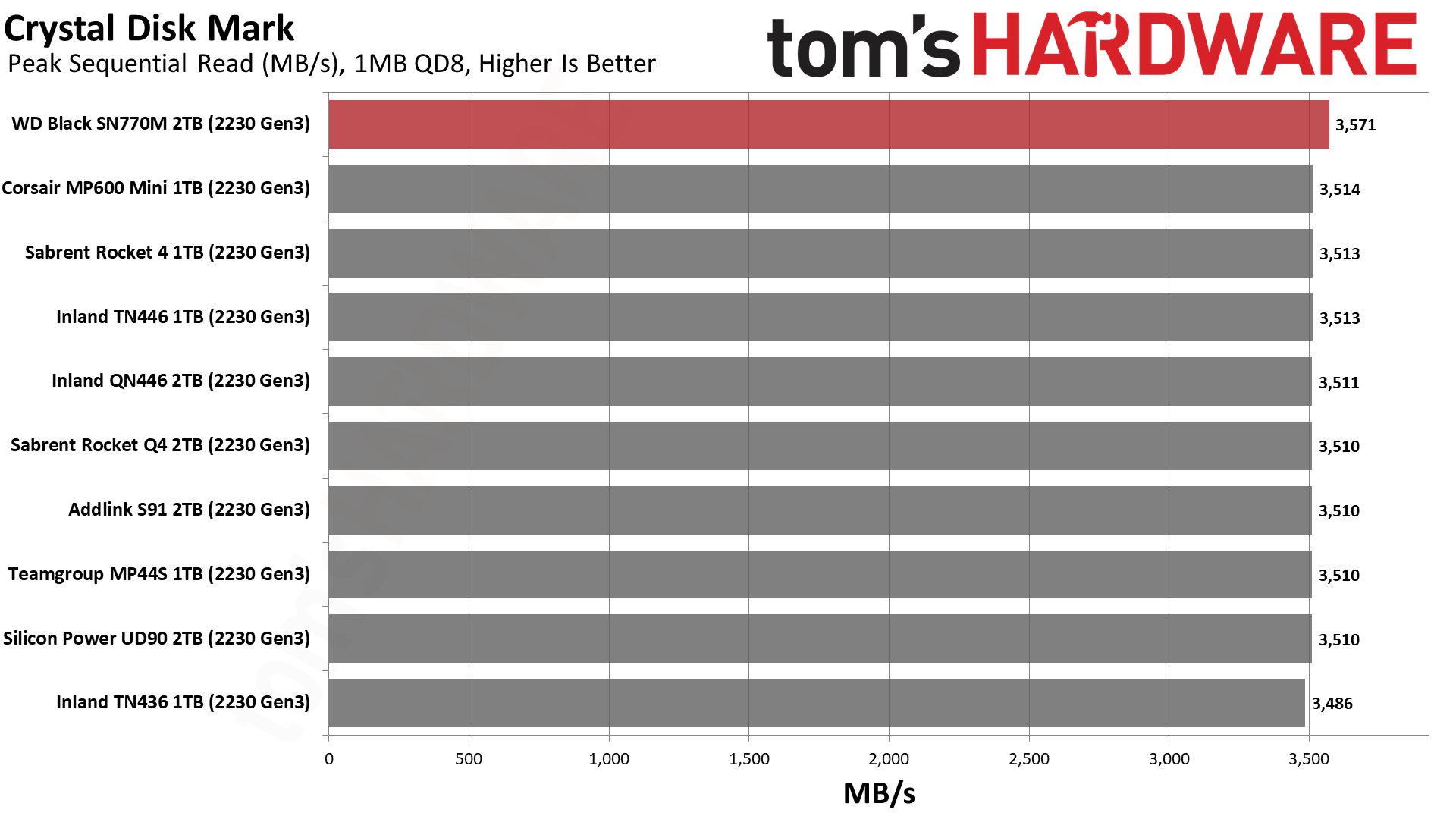
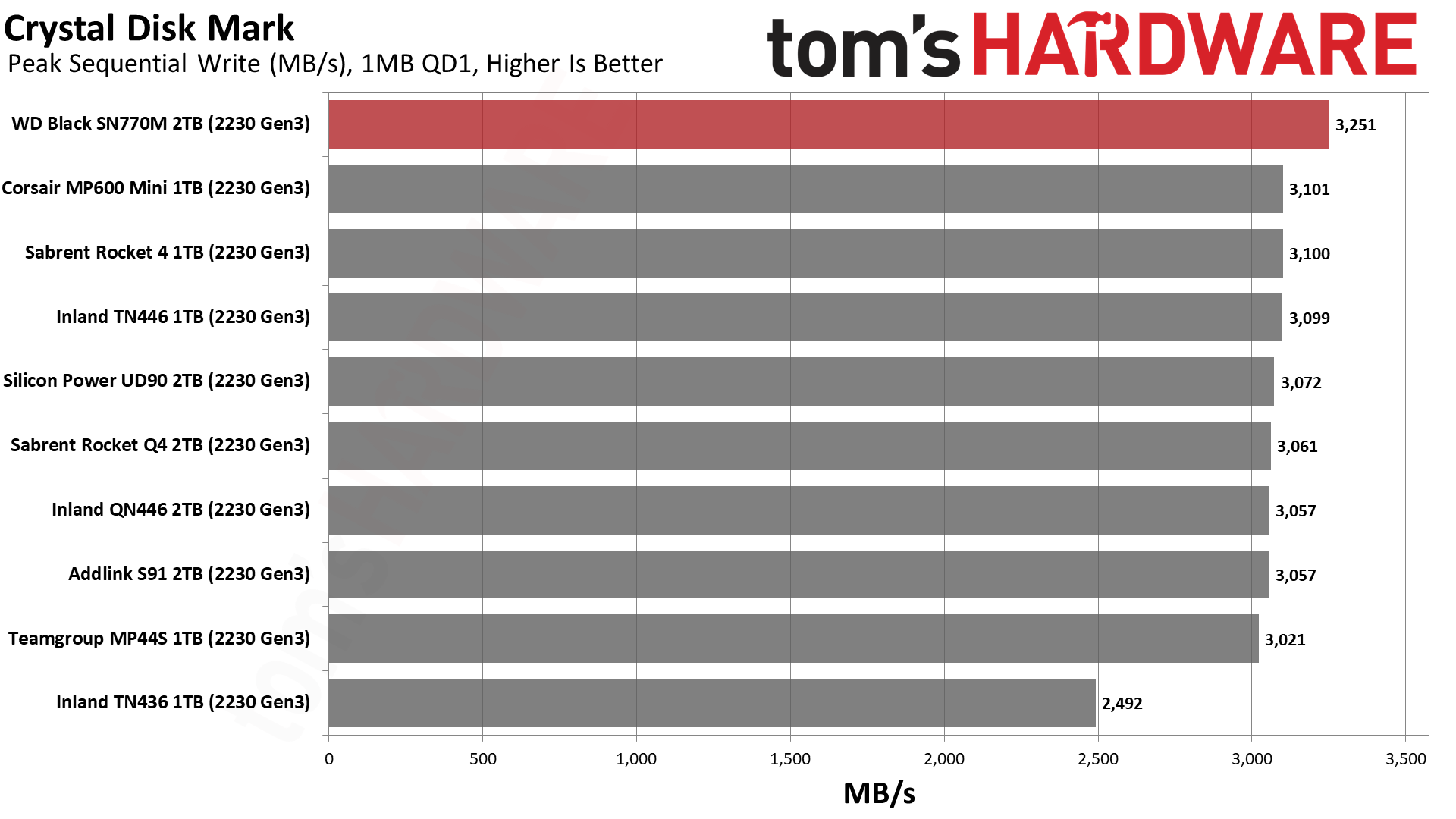


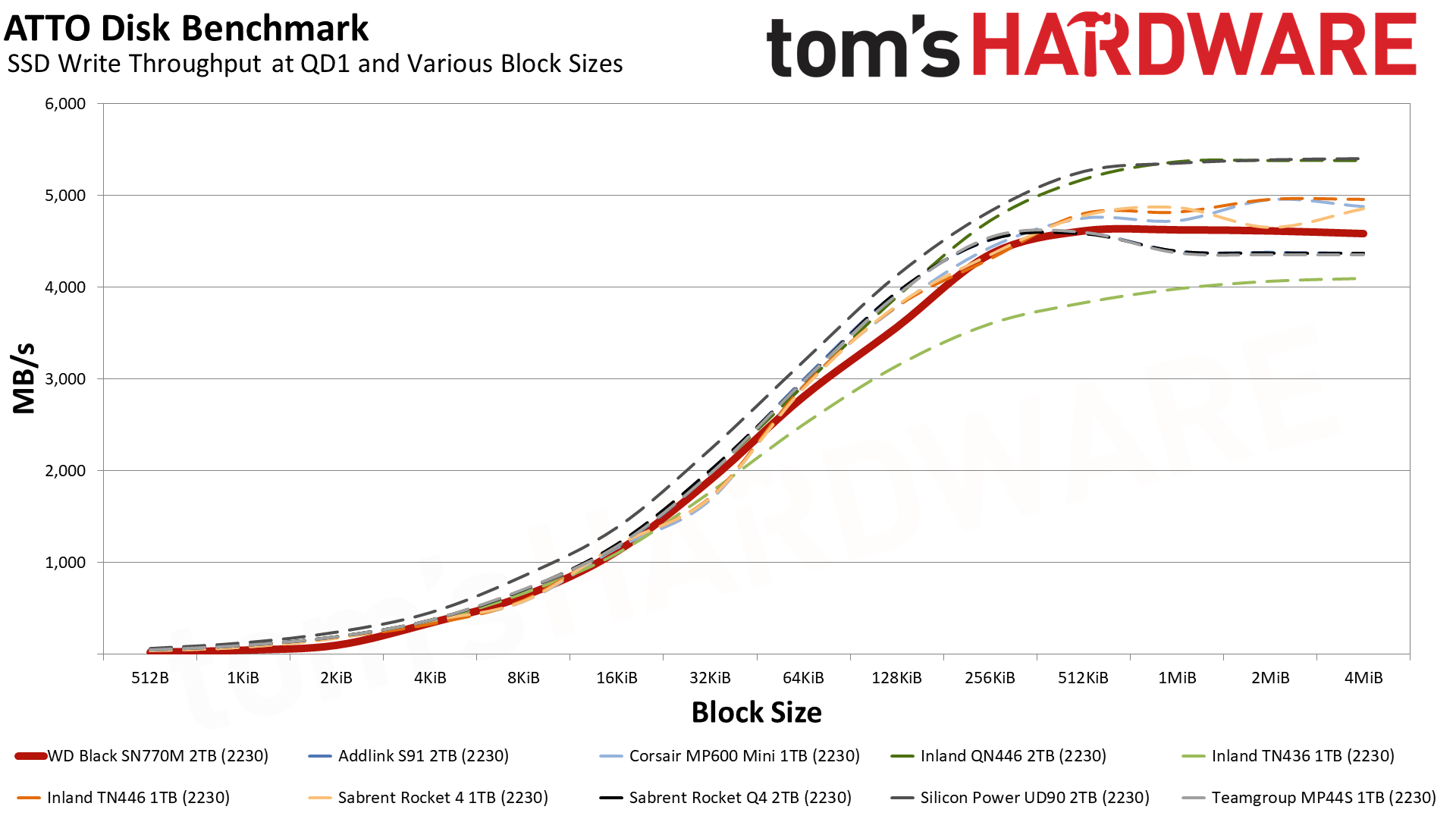


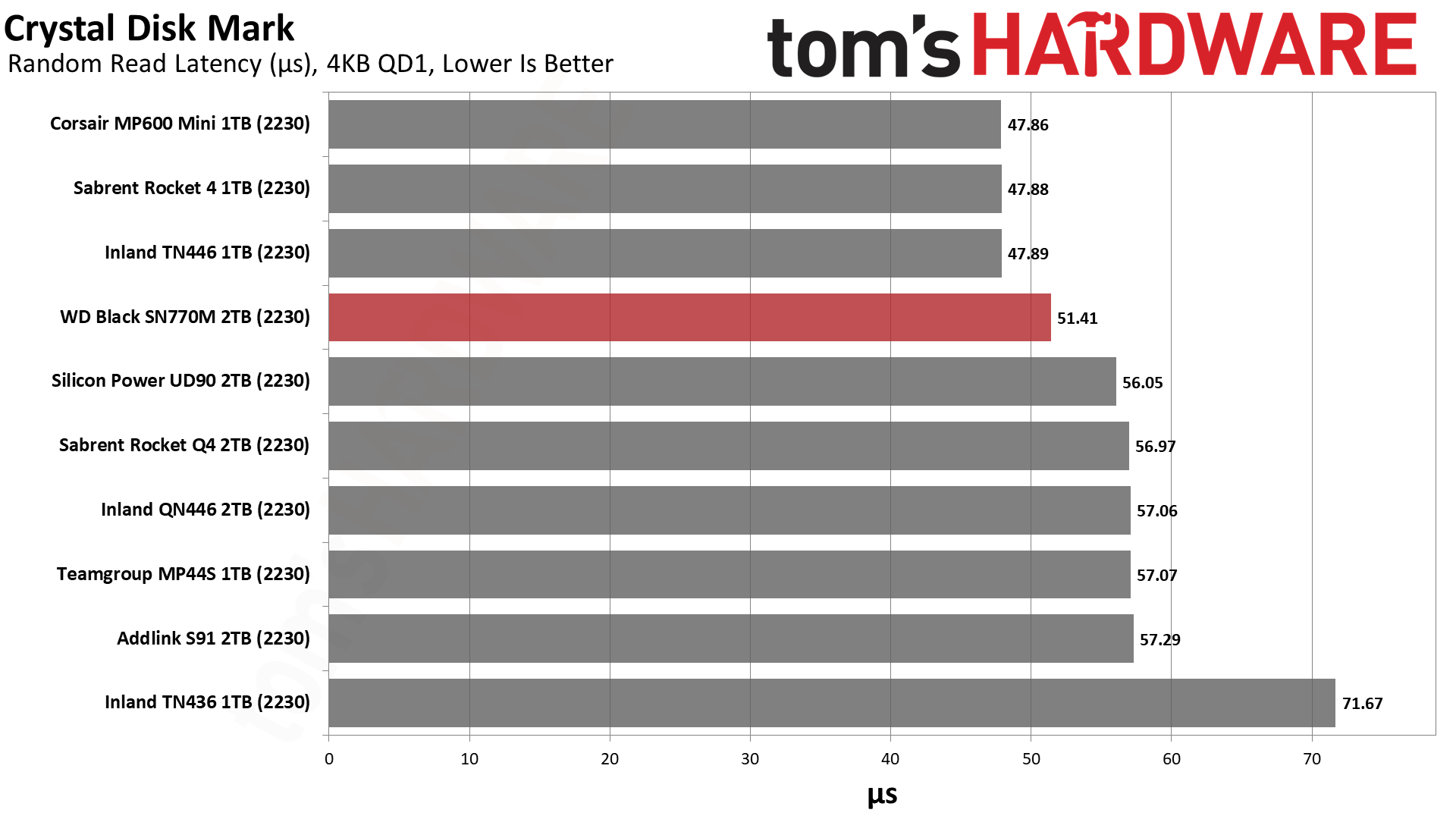







The SN770M is relatively smooth in ATTO aside from a valley at the 1MB block size for reads. This might be due to passing an interleaving barrier or just a nuance of the controller. The drive can mostly keep up with the competition in PCIe 3.0 mode, but it starts to trail in 4.0 mode. The Phison E21T controller and Micron’s flash consistently provide better results. The TN436, using older PCIe 3.0 hardware, falls behind everywhere.
CDM’s sequential results paint a different picture. The SN770M dominates everywhere, with reads and writes in both PCIe modes. Its advantage over the other TLC drives isn’t very significant, though, aside from QD1 sequential reads in PCIe 4.0 mode, which could be relevant in select cases. The QLC drives fall behind when the PCIe 4.0 interface opens up for sequential writes. Usually, you would need two drives or a very fast interface to use extra performance, which isn’t relevant for many of the intended host devices.
Random performance is more of a mixed bag, and the SN770M is merely average on the whole. You’ll get the best random read performance, regardless of mode, with the TLC drives using Phison’s controller. These are limited to 1TB, though. The SN770M is faster than the 2TB QLC alternatives by a significant amount in both modes for always-relevant 4KB, low-QD random reads.
PC Sustained Write Performance and Cache Recovery
Official write specifications are only part of the performance picture. Most SSDs implement a write cache, which is a fast area of (usually) pseudo-SLC programmed flash that absorbs incoming data. Sustained write speeds can suffer tremendously once the workload spills outside of the cache and into the "native" TLC or QLC flash.
We use Iometer to hammer the SSD with sequential writes for 15 minutes to measure both the size of the write cache and performance after the cache is saturated. We also monitor cache recovery via multiple idle rounds.






In PCIe 3.0 mode, the SN770M writes in pSLC at over a 3.1 GB/s rate. In PCIe 4.0, this increases to an average of around 4.5 GB/s. The cache size in both cases is about a third of the drive’s capacity, implying it uses all of the TLC flash in pSLC mode. This cache will shrink as the drive is full along this ratio. This is an aggressive cache, so it also recovers relatively quickly when the drive is given idle time.
This aggressive caching scheme also means the drive must hit a folding state, which is quite slow, between 300 and 400 MB/s in a steady state. This is still significantly better than the QLC drives but far behind the Rocket 2230, MP600 Mini, and TN446. The overall write pattern is not as consistent, either. Prolonged writes do not favor the SN770M, but it handles bursty workloads quite well.
PC Power Consumption and Temperature
We use the Quarch HD Programmable Power Module to gain a deeper understanding of power characteristics. Idle power consumption is an important aspect to consider, especially if you're looking for a laptop upgrade as even the best ultrabooks can have mediocre storage.
Some SSDs can consume watts of power at idle while better-suited ones sip just milliwatts. Average workload power consumption and max consumption are two other aspects of power consumption, but performance-per-watt is more important. A drive might consume more power during any given workload, but accomplishing a task faster allows the drive to drop into an idle state more quickly, ultimately saving energy.
For temperature recording we currently poll the drive’s primary composite sensor during testing with a 24C ambient.








As expected, the SN770M is fairly inefficient. It’s not as bad as the last-generation TN436, but it falls far behind the rest of the competition. This gap is significant in both modes, meaning that the small advantage offered by the Steam Deck’s PCIe 3.0 interface is not enough to put the SN770M into contention. Idle consumption with desktop settings is also high; however, devices like the Deck are very good at power-saving, which is less relevant for battery life.
Peak power draw is much higher, which is a bigger concern as it could consume a larger proportion of the device’s overall power budget, and the wider power range is less consistent. This especially has an impact on thermal overhead. During testing, the drive reported a maximum of 95C in PCIe 4.0 mode and the idle temperature was higher, too. This wasn’t a big deal in the limited testing we did in the Steam Deck in PCIe 3.0 mode, as shown below, but it could be an issue during prolonged gaming sessions. Portable PCIe 4.0 devices especially could benefit from additional M.2 cooling with this drive, as regularly pushing beyond the critical temperature could have long-term adverse effects.
Test Bench and Testing Notes
| CPU | Intel Core i9-12900K |
| Motherboard | Asus ROG Maximus Z790 Hero |
| Memory | 2x16GB G.Skill DDR5-5600 CL28 |
| Graphics | Intel Iris Xe UHD Graphics 770 |
| CPU Cooling | Enermax Aquafusion 240 |
| Case | Cooler Master TD500 Mesh V2 |
| Power Supply | Cooler Master V850 i Gold |
| OS Storage | Sabrent Rocket 4 Plus 2TB |
| Operating System | Windows 11 Pro |
We use an Alder Lake platform with most background applications such as indexing, Windows updates, and anti-virus disabled in the OS to reduce run-to-run variability. Each SSD is prefilled to 50% capacity and tested as a secondary device. Unless noted, we use active cooling for all SSDs.
Bottom Line
We think the WD Black SN770M is an excellent addition to the M.2 2230 SSD stable. 2TB of high performance in a short, single-sided package is nothing short of amazing, given the long road SSDs have taken to get to this point. Older 2.5” SATA SSDs could have sixteen or more thick planar NAND packages just to get a fraction of this much space. Now you can manage it in a 22x30mm form factor that only uses one side of the PCB - with a height measure of just 2.38mm - for componentry. It’s a marvel, but this is just the beginning as higher-layered, denser TLC flash is coming to market.
Of course, the demand for space has also increased as games have gotten bigger over time. There’s some hope for compression with DirectStorage and similar technology, as designed to help accommodate space-limited consoles, but high-quality assets scale faster in size than quality. On the other hand, portable devices are quite limited in what they can do as relatively small batteries put a reasonable cap on power draw. There’s also the possibility of swapping memory cards for storage, a media type that offers “good enough” game loading performance for now. The amount of storage you really need is debatable, but it’s nice to have a fast, 2TB option.
The fact that such a dense, small form factor drive has to go into a portable device does bring some concerns, though. Power consumption and heat production are relevant with regard to maintaining longer battery life and towards any effort to prevent thermal throttling or hardware damage. The SN770M has the potential to pull more power and put out more heat than any of its competitors, which could raise some questions about long-term reliability. This is certainly true of laptops and any PCIe 4.0 devices that might see heavier workloads. If your device has the extra physical space, we recommend DIY cooling with at least thermal padding.
If you don’t really need 2TB to store all of your immediate games, ROMS, and files, we recommend sticking to drives using the tried and true Phison E21T controller with Micron’s 176-Layer TLC - this includes the Sabrent Rocket 2230, the Corsair MP600 Mini, the Inland TN446, and other similar drives. These SSDs are not without their problems but provide the best overall experience. The switch from TLC to QLC with the E21T controller - that is, by going with the Rocket Q4 2230, the Addlink S91, the Corsair MP44S, or similar - comes without any major downsides. The 2TB QLC options are efficient and can provide solid performance in the PCIe 3.0 Steam Deck and good enough performance in PCIe 4.0 devices, although there are edge cases for which you should be watchful.
There are also OEM options, which include the WD SN740, although we recommend going full retail when possible. Upcoming M.2 2230 SSDs may overcome the shortcomings of the SN770M, but this is a difficult predictive pathway to navigate given the tumultuous nature of current memory markets. You may also be asking for DRAM on your drive, which does exist for some OEM solutions like that SK hynix BC711 but generally precludes higher capacities.
That leaves the SN770M as the best option for maximum performance at 2TB for M.2 2230/2242 host devices. It’s great at lower capacities, too, but its pricing is not very competitive, so the 2TB remains the star of the show.
MORE: Best SSDs
MORE: Best Hard Drive
MORE: Best SSD for Steam Deck

Shane Downing is a Freelance Reviewer for Tom’s Hardware US, covering consumer storage hardware.
-
watzupken I see no reason to rush and get SSDs with 2230 form factor. Companies are rushing to deliver SSDs in this form factor because they can charge more, while I believe the cost to produce may be the same or lower than 2280 variants. So margin is a lot higher. At some point, it will get too saturated and price will surely take a hit. I don’t believe PCs or handheld consoles requiring SSDs in 2230 form are selling like hit cakes, and given you can generally only get 1 drive in handheld consoles, so this market will hit a wall pretty soon. Not to mention the performance is also compromised as compared to cheaper 2280 variants.Reply -
JarredWaltonGPU Reply
The Steam Deck has sold something like 3 or 4 million units already, and every single one came with at most 512GB of storage. The OLED version now has a 1TB option, but still no 2TB model. That doesn’t account for any of the other competing handheld gaming PCs like the Ally, plus some laptops. Regardless, that’s certainly enough to create a market for M.2 2230 drives.watzupken said:I see no reason to rush and get SSDs with 2230 form factor. Companies are rushing to deliver SSDs in this form factor because they can charge more, while I believe the cost to produce may be the same or lower than 2280 variants. So margin is a lot higher. At some point, it will get too saturated and price will surely take a hit. I don’t believe PCs or handheld consoles requiring SSDs in 2230 form are selling like hit cakes, and given you can generally only get 1 drive in handheld consoles, so this market will hit a wall pretty soon. Not to mention the performance is also compromised as compared to cheaper 2280 variants.
I agree prices will come down, and good 1TB drives already exist, for as little as $70. But if you want 2TB, this is the best pick right now.
